Homeschooling: Teaching your kids to appreciate their Filipino heritage (Homeschool conference 2014 Part 2)
This is part 2 of my series of blogs on the recently concluded Home school conference 2014.
If you have not read the first part wherein I shared about the roles of fathers in home schooling their children as I have picked up from the conference, click here.
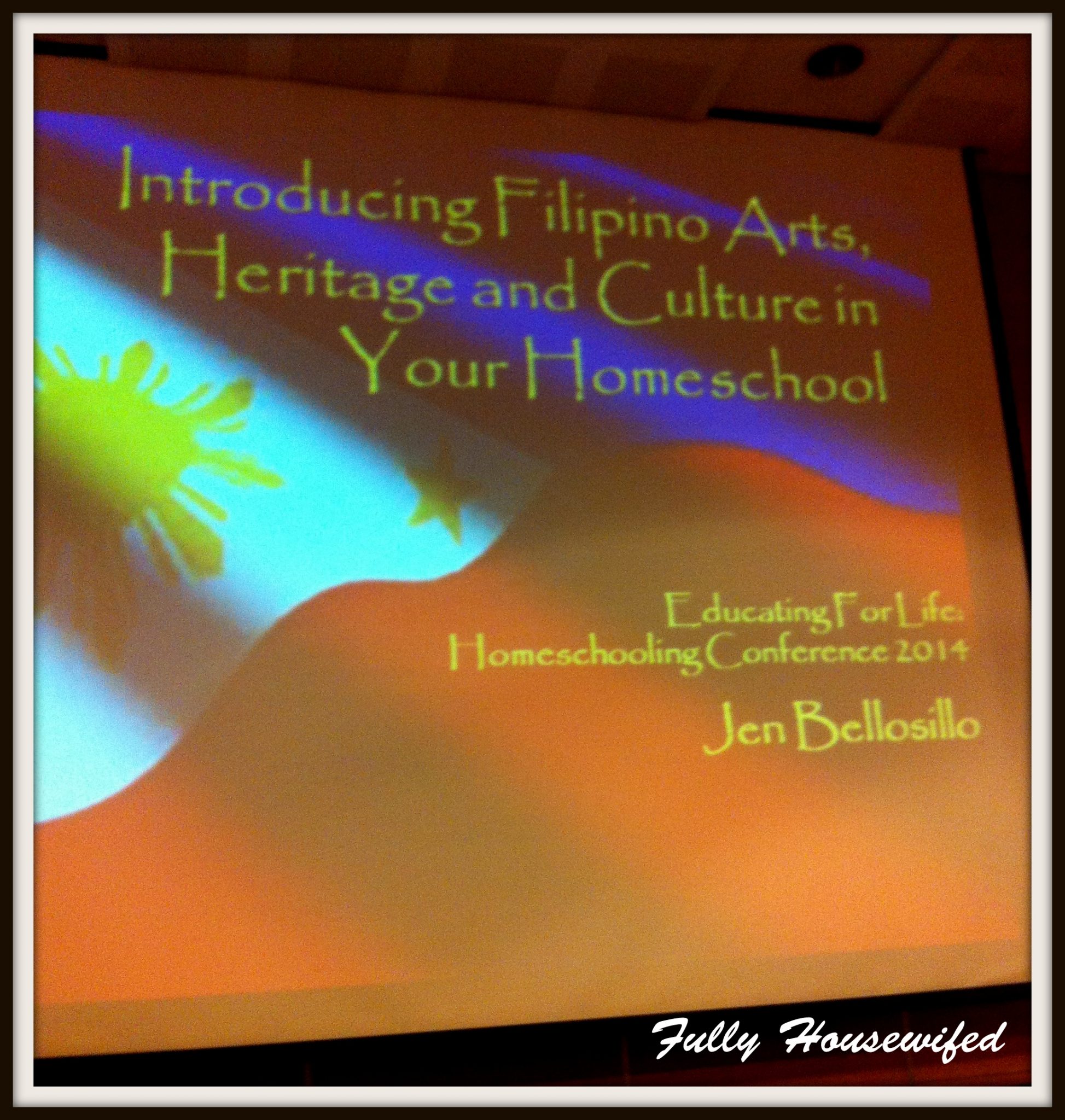 This blog will focus on what I thought was one of the most important topics taken up that day: Introducing Filipino Arts, Heritage and Culture in your home school.
This blog will focus on what I thought was one of the most important topics taken up that day: Introducing Filipino Arts, Heritage and Culture in your home school.
The speaker was Jen Bellosillo who coaches home schooling families enrolled at CFA or Catholic Filipino Academy. Jen has been home schooling her three kids for six years and at the time of the conference, was due to go into labor with her fourth child any minute.
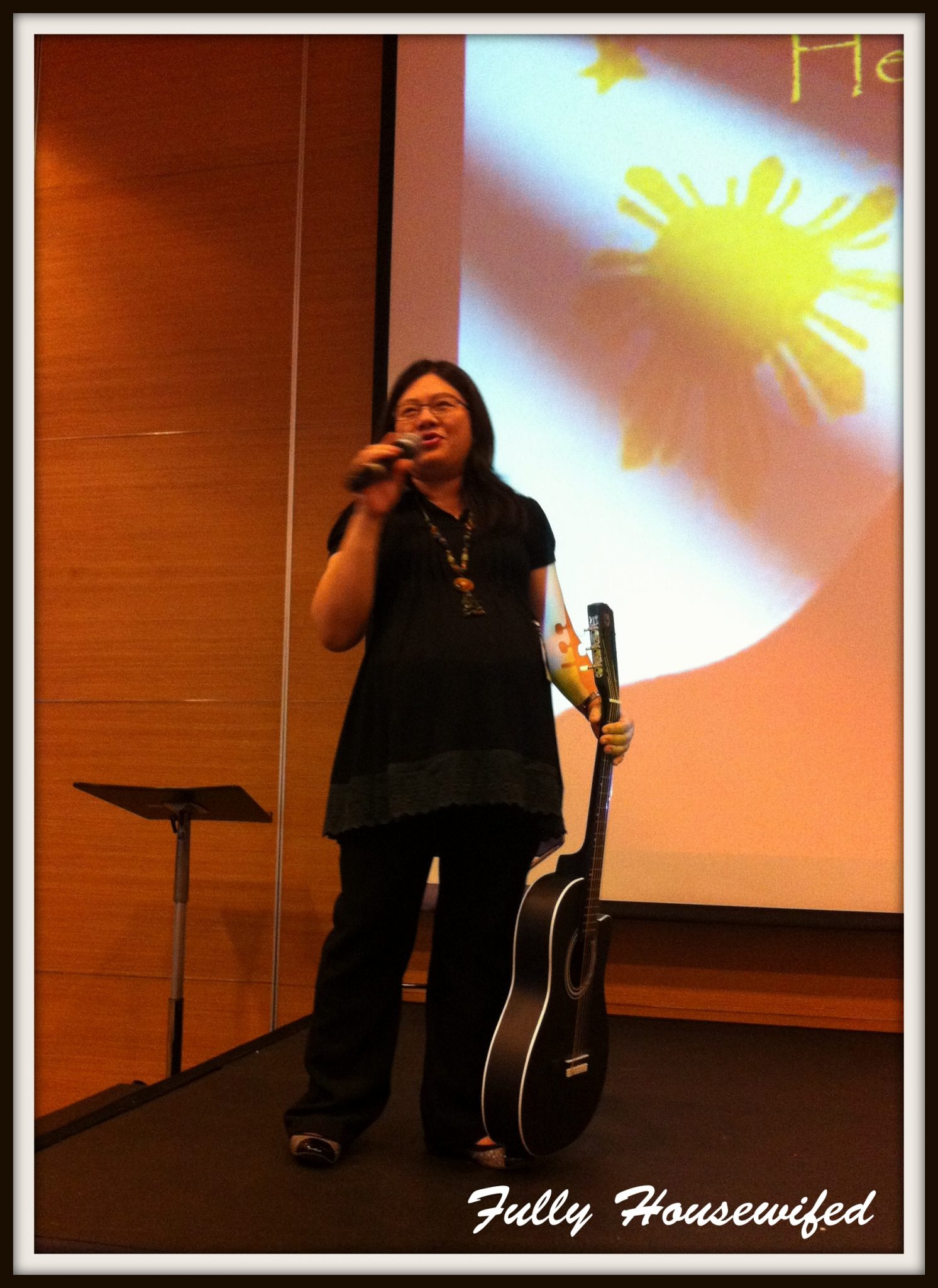 I think that it’s an important topic because there are now so many home schooling children having difficulty, not only in learning the Filipino language, but also in connecting to our heritage and culture.
I think that it’s an important topic because there are now so many home schooling children having difficulty, not only in learning the Filipino language, but also in connecting to our heritage and culture.
I thought that it was awesome that the organisers thought about including this, as many families, ours included, need help in this area.
Demonstrating techniques
Instead of launching into a boring lecture of 1, 2, 3s, Jen Bellosillo demonstrated the techniques that we can use to teach our kids.
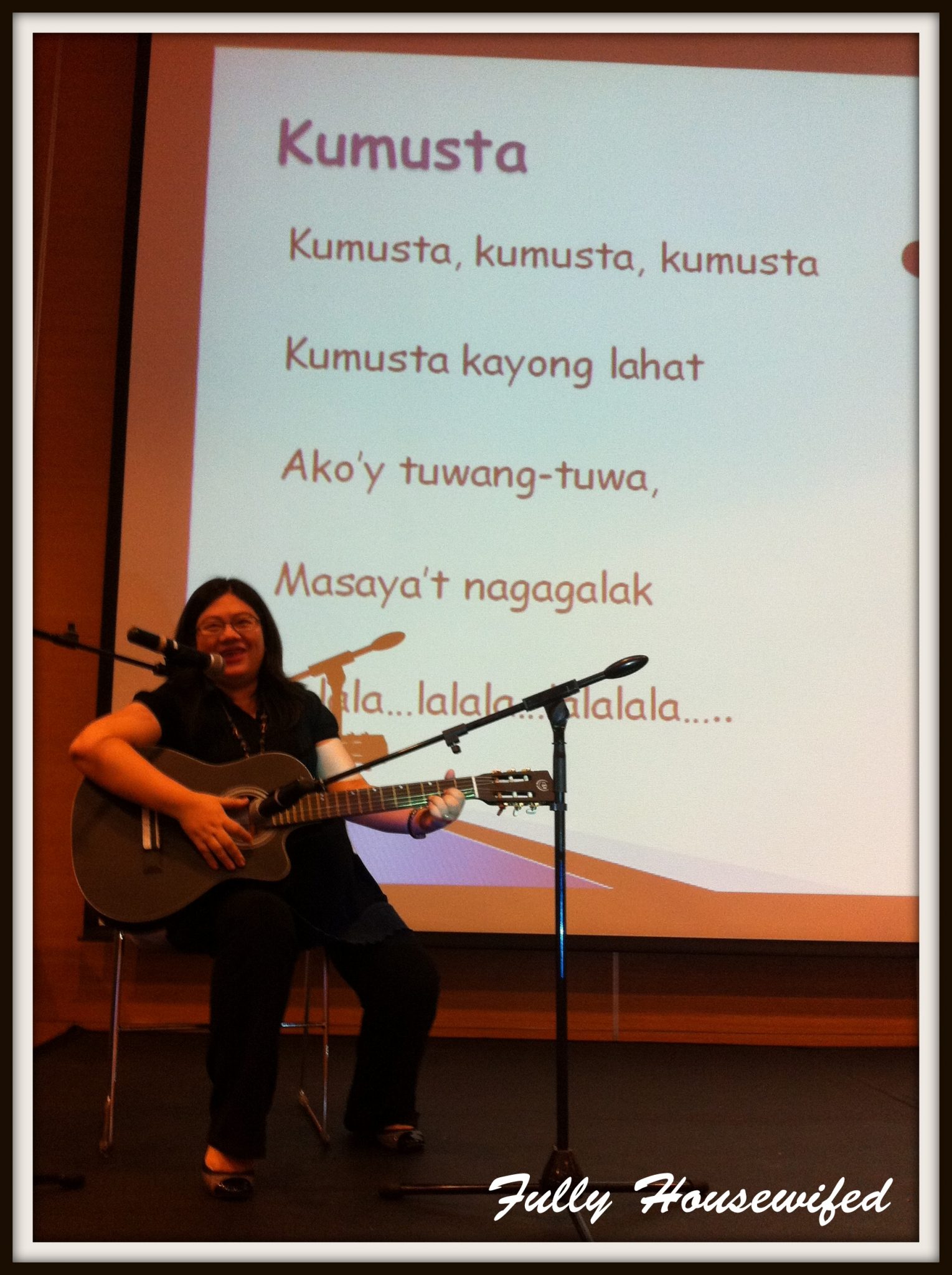 Strumming her guitar, she led a class of eager, wide-eyed parents in singing many different Filipino songs.
Strumming her guitar, she led a class of eager, wide-eyed parents in singing many different Filipino songs.
By the time we were singing “Tong Tong Tong Tong Pakitong kitong” in different syllables, we were all cracked up!
Games and costumes
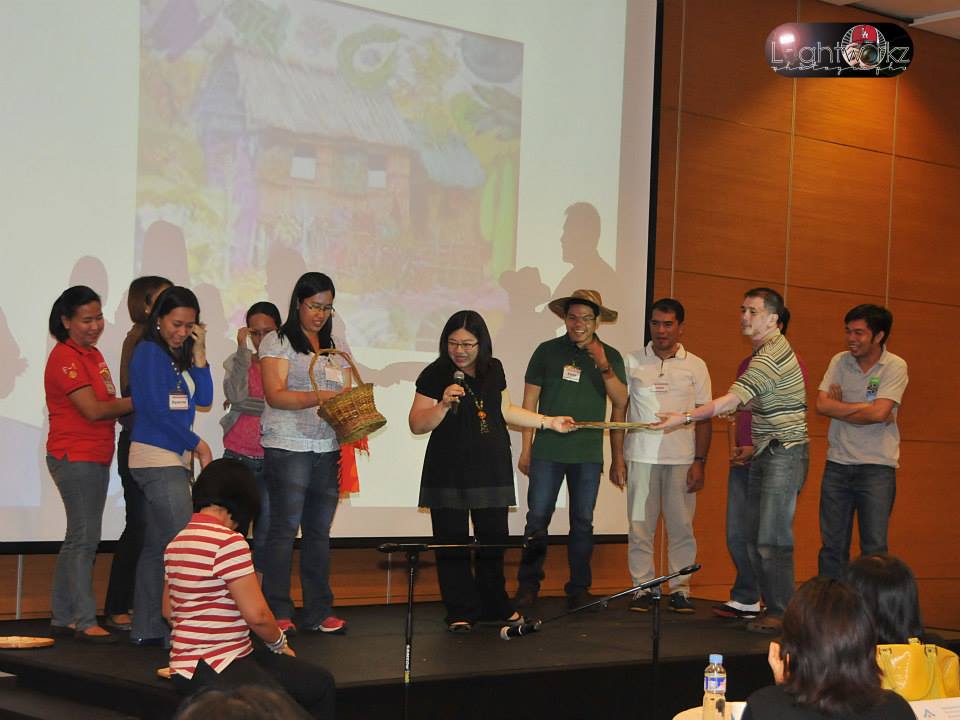
Jen also re-introduced us (I’m saying ‘re-introduce’ because in my case, they were taught to me in my childhood) to a Filipino relay game that challenges participants to remember the lyrics to the Filipino folk song, “Magtanim ay di biro” (Planting rice is never fun). The main objective of this game is to be able to identify the vegetables included in the song.
She made the participants wear the traditional Filipino Salakot (traditional farmer’s hat) and scarves, and made them carry a woven basket and a rice winnower.
The game was called Tinakad.
Tinakad is a relay wherein the participants have take off their shoes and walk on coconut shells tied to strings. In this version of Tinakad, though, the players each had to sort through pictures of vegetables at the other end of the stage and get one that’s included in the song to bring back to their team.
The team with the most number of correct vegetables in the basket wins.
Using this method, you would have already taught a group of kids a Filipino game, a Filipino song, the names of the vegetables in Filipino, team work, and practiced their memory skills, on top of everything else they will learn from the activity.
It was also an example of Integrated home schooling, which Jen Bellosillo discussed in the session.
Integrated home schooling
Citing a locally produced story book, Haluhalo Espesyal by Yvette Ferreol, Jen showed us how you can use one book as your main material for a week’s syllabus.
Here’s the illustration she shared with us:
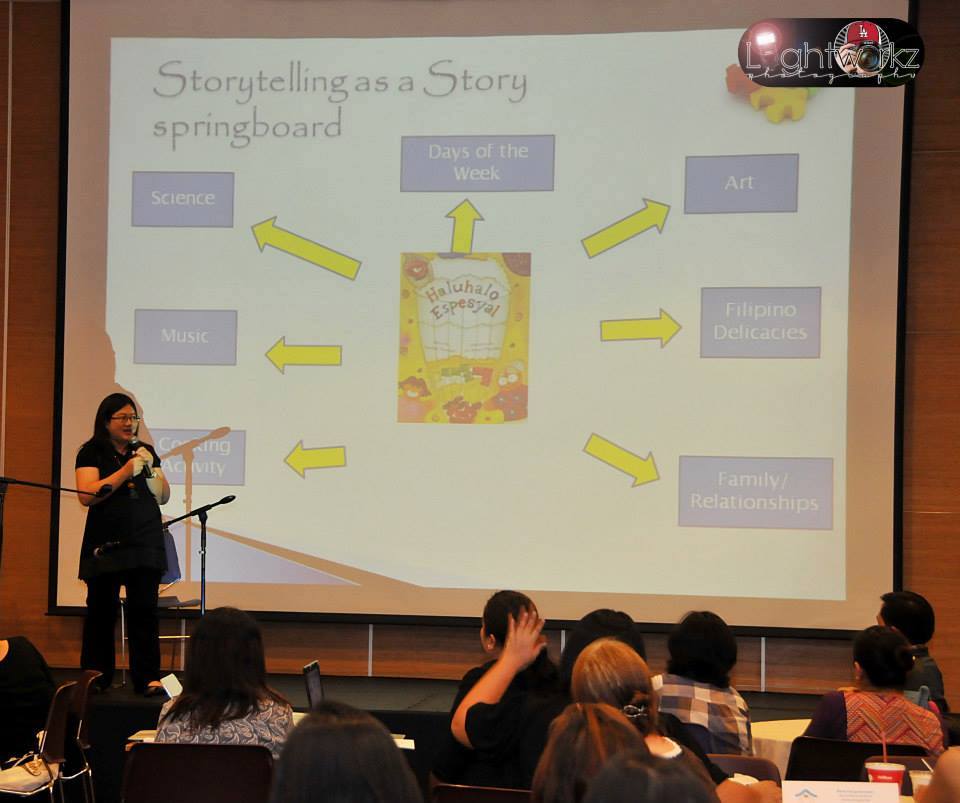
Make use of technology
Jen encouraged us to use technology to benefit our home schoolers. She reminded us of the wealth of Filipino songs for kids uploaded on Youtube.
She also mentioned the kiddie show, Batibot and other educational shows that you can find online.
Lessons from the session:
It was really a fun session! It was dynamic, too, Jen had all of our attention from the time she took the mic until we had to rush back to Jay’s workplace (yeah, sadly, we had to go right after). In fact, I wasn’t able to take notes because I was hanging on to everything she was saying and doing.
On top of my head, here are some of the things I learned from her:
1. Be fun
As the parent, you must initiate the fun factor. Play games, use instruments, wear costumes, cook, bake, and most importantly, SMILE AND HAVE FUN with your kids!
2. Integrate
Integrating everything from one material is a creative way of simplifying your home school. As a cliche goes, hit so many birds with just one stone.
3. Sing
Kids love music. The best way for them to remember anything is to teach it to them through songs.
I believe this! I sing my kids 3 lullabies from the time they were born- one of which is a tune I created for Proverbs 86:11-12, in the hope that my children will remember to live their lives with an undivided heart for God.
4. YouTube it!
This is one of the ways you can put technology into good use. And YouTube isn’t the only tool you can use to teach your kids. CDs and DVDs can be of use too! Be resourceful!
Trying the method at home
The sessions were more directed to parents teaching younger kids which was so applicable to us.
A week later, I got my kids to gather around my lappie to learn the song “Sampung Malulusog na Bata“ (10 Healthy kids). They seemed to have fun singing along.
Lukas garbled the rest of the numbers after “lima” (five) and replaced the rest of the words with unintelligible syllables and Judah just danced along, but I think, in time, and with patience and determination, this could work for us!
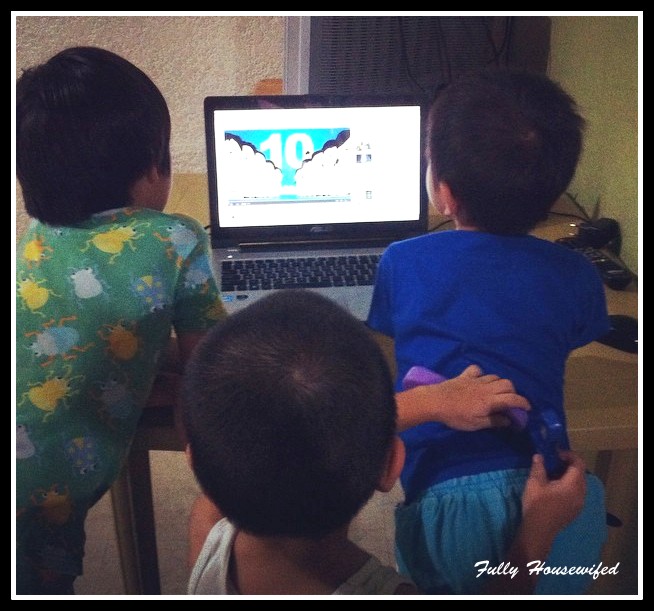 Stay tuned for the last blog for this series!
Stay tuned for the last blog for this series!
The session with Jen Bellosillo was the last session we were able to attend. Jay had an emergency at work and we had to grab a cab soon after. We missed Ivy Marquez’s talk about nurturing the love for learning. Ivy Marquez is a veteran home schooling mom with two kids in College and another already making waves in the web industry.
We also missed the session with Truly Rich Mom, Tina Rodriguez who discussed Homeschooling 101. You can read fellow Mommy blogger, Kat’s account on it at Petite Momma’s World.
Next week, I’ll be blogging about the sessions with veteran home schooling parent, Irma Chua and home schooling momma with a rockin’ hairstyle, Yen Galagnara, to conclude this blog series on the home school 2014 conference.
Until then…happy home schooling!
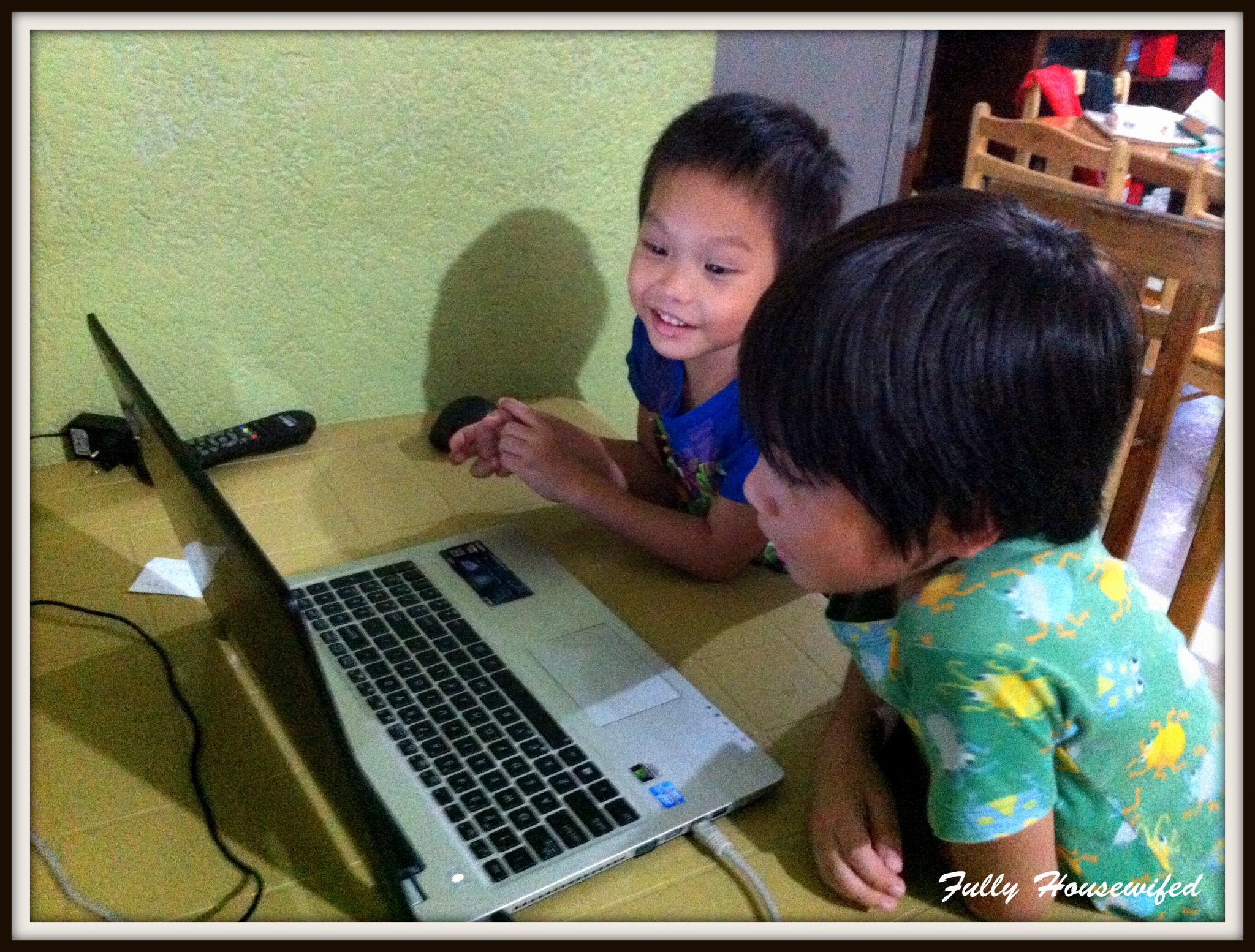
40 Comments
Pingback:
Louisa Mercado (@2livelovelaugh5)
We also tried homeschooling but didn’t find it to be a god fit for the kids. I think it’s because we started when they were already in middle school. I know how hard it is too get them interested in subjects and these are all good ideas.
May De Jesus-Palacpac
If I’m not mistaken, Martine De Luna was home schooled in the beginning of her third year in high school. 🙂 But yes, it’s not for everyone. It really depends on direction the family wants to take and the circumstances around you. For us, home schooling is the best option to take. 🙂
reaesc
That seems to be a very great experience for you mommy May! I am also planning to home school my son who has developmental delays but I’m worried about his Socialization. I want to learn more about homeschooling and I hope to find a more affordable home school program, most programs are worth more expensive than those exclusive schools in our place.
May De Jesus-Palacpac
Socialization, or lack thereof, is the biggest misconception on home schooling. Unless, of course, you plan to keep your child away from other people, he will not lack socialization.
The advantage of home schooling is that you can guide your child on socializing with people who share the same values as you. Another is that they’re not limited to the same age (horizontal socialization). Most home schooled children have enough confidence to get into conversations with people of different ages, gender or economic status. (Vertical socialization):)
Que Sullano - Gavan
We are homeschooling but no in-depth teachings on Filipino heritage yet. We have plenty of time, I guess, since Gab is just 3.
May De Jesus-Palacpac
It’s really up to you when you plan to get into it. 😉
Kristina
I’m homeschooling my 3 year old son. It’s good to be reminded that we should incorporate teaching about our Filipino Heritage. We rarely speak to our son in Filipino and sometimes I’m bothered that he responds only when we talk to him in English.
May De Jesus-Palacpac
We are the same. But ms Irma, she homeschooled for 20 years, said her children learned Filipino when they were about to go into College. So there really is hope for us. 😉
Liz A
it is easy to integrate this kind of activities for home schooling class i think. but i hope they integrate these kinds of teaching technique as well to regular schools since, even if the kids are in regular school, they still have a hard time learning the Filipino language especially when their first language was English.
May De Jesus-Palacpac
I think progressive schools already do this…:)
Liz A
i’m not quite familiar with progressive schools.. i might check that out.. thanks! 🙂
Maan
Yes this is so so important! I think it’s sad that kids nowadays don’t know anything about their culture. Kahit language di alam. Thank goodness for homeschooling!
May De Jesus-Palacpac
On my end, it was my mistake. I assumed it would be easy for my kids to learn the language and take to the culture. Narealize ko hindi pala madali ituro and our kids are not exposed much to our culture. So kailangan talaga deliberate.
ceemee
What informative ways, not to mention fun, to teach the Filipino language and culture. I didn’t grow up knowing these Filipino songs. I didn’t even memorize Bahay Kubo. On top of Filipino, we were also learning Chinese history and culture. I think for children it’s really about how fun it is to learn this or that. That’s how they retain info, in my experience.
Cheanne
As far as Filipino culture and heritage is concerned, I’ve only managed to teach sitaw bataw patani to my son haha. I should try more of what you learned from the conference like searching in YouTube. I just never thought there were much Filipino resources uploaded. Just an added input, if ever you drop by the Pasay/MOA area, there’s this buffet restaurant called La Fiesta. Aside from the Filipino dishes, they also provide Filipino entertainment, like folk dancing there. And they let the audience try the tinikling too. So, it’s a nice Filipino heritage immersion. 🙂
May De Jesus-Palacpac
Thanks for the input, I really appreciate it. I saw a blog on another resto in Intramuros that does the same thing and was planning to take the kids there which will take more planning. La Fiesta would be more accessible to us. 🙂
Kat | Petite Momma
Thanks for linking me back, Mommy May 😀
We’ve made a choice to make Filipino be the first language in our home (although in the beginning it wasn’t like that). So far that’s the only thing we’ve covered for Filipino heritage at home. Oh, and yeah, he knows what a Philippine flag looks like. 😀 Sana may makita ako na old Batibot videos. I miss Kiko Matsing 😀
reigne
i really think teaching the kids filipino culture is an important aspect of education, home schooled or not. Its great that you really make sure you cover everything for your kids’ education. Bilib ako sa mga mums who home school their kids.
Shiella A
We use local dialect in our home and even introduce traditional songs for kids and even local food and delicacies to our kids. But I guess these are not enough 🙁 Homeschooling sure does intrigues me.
May De Jesus-Palacpac
Naku mommy Shiella, in my opinion, you’re doing exceedingly well compared to most of us, haha. How I wish I talked to my kids using our local dialect from the start!
Anna “Mommy Anna” Plaida
It’s nice to see that you do home schooling and your kids seems enjoying it. Before I was thinking if I can also do the same but since I am a working mom I cannot do it. And I need him to expose with other kids since he is the only child in our house and he is not allowed to go out and play with other kids. Hope that someday if I become a WAHM and have another kid will definitely do the homeschooling.
leirs (@leirs)
This is very informative even for parents like me who don’t homeschool.
May De Jesus-Palacpac
I’m glad. that’s my goal. home schooling shouldn’t really be a place of exclusivity. parang open-sourced software yan, anyone can contribute. 🙂
Patty | MrsC
It looks like you guys all had fun at the homeschooling conference! I wish I could have seen everybody there.
May De Jesus-Palacpac
yes it was fun. nakaka proud ang mga WAHMs involved in the event organisation. 🙂
mommadaise
Hi May! It’s me Daise, I approached you during the conference (hope you still remember). Really feel happy and inspired after reading your blog posts about homeschooling-love how you write! My kids also learned to speak our language first before English. Medyo baliktad naman concern ko kasi they don’t want to converse in English as much as I want them too. Kaya pag may homeschooling even/ get-together, I feel pressured that my kids are not that fluent in English LOL 🙂
May De Jesus-Palacpac
Hi Daise! Yes, of course I remember. I wish we had more time to exchange notes but it got a bit busy na after lunch and I couldn’t find where people were anymore. 🙂 Maybe next time.
Don’t be pressured, kids have a way of growing into anything. 🙂
Thank you for your encouragement. It’s great to know that my blogs are useful to others. 🙂 That’s really what I have been hoping for.
mommadaise
Thanks for the encouragement May! And yes, would definitely chat with you more next time and take some pictures too! God bless you and your family dear!
nhessie a.
i haven’t planned whether i’ll homeschool choi but gauging from your experience, i think the parents play major roles in keeping their kids engaged and interested in homeschooling. i need to research more about this.
May De Jesus-Palacpac
yes, read a lot about it first before making the decision. that way, if you do decide on it, you’ll start on the right foot. 🙂
Janice / The Roller Coaster Ride
I really believe in the importance of kids learning more about their Filipino heritage. That’s why it bugs me how sometimes the interest for learning those things get lost amidst all the memorization traditional schools tend to force on school children. I hope that I’d be able to make learning Filipino more fun for Ziggy now that we’re starting to homeschool him. I especially love the integrated homeschooling idea!
Pingback:
Pingback:
Paulline @ milastolemyheart
October is Museum & Galleries Month and National Museum offers free admission. I think museum visits are a great and effective way in teach2kids about their Filipino Heritage.
May De Jesus-Palacpac
Thanks for the info. I’ve heard of the museum and galleries month last year — is that the time when all local museums open for free? Anyway, scheduled to visit the national museum soon. 🙂
Mitch Ryan (@mitchryan23)
It is good that homeschooling gets a lot of support. It is important to be always updated.
Jen Bellosillo
Thank you so much Mommy May for attending the session on “Introducing Filipino Arts, Heritage and Culture in your Homeschool”. I really appreciate your wonderful review of my talk and I am happy that you enjoyed it as much as I enjoyed sharing strategies, songs and experiences with everyone. May we all be blessed in our homeschooling journey.
May De Jesus-Palacpac
Thank you for what you’ve imparted in that session. It was the very session I was looking forward to in that particular conference because I really needed help in that area. 🙂
Pingback: